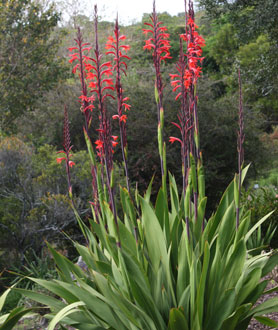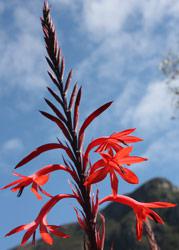Watsonia vanderspuyiae
Watsonia vanderspuyiae L.Bolus
Family: Iridaceae
Common names: bergsuurkanol (Afr.)
Introduction
Watsonia vanderspuyiae is a robust geophyte with bright red tubular flowers. It attracts sunbirds and is an ideal candidate for large fynbos gardens, parks, office block landscapes and traffic islands, and is deserving of a more prominent place in ornamental horticulture.

Description
Description
Watsonia vanderspuyiae has the largest corms, broadest leaves and tallest spikes of all watsonias. The very large, laterally flattened corms are up to 120 mm in diam. and surrounded by tough, netted, brownish outer tunics. The corms are offset-forming and produce 3 or 4 bright green, erect leaves with reddish bases. The leaves are broadly lanceolate and up to 100 mm wide, with strongly thickened, brownish-yellow or reddish margins, each leaf narrowing above into a long, sharp apex.

The branched flower spike reaches up to 2 m high and is held on a sturdy reddish-brown scape (flower stem) with several inflated, leaf-like bracts. About 20-30 large, bright red, zygomorphic (irregular) tubular flowers are produced, each with a long, curved perianth tube up to 50 mm long. Each flower emerges between two prominent, dry brownish bracts. The six tepals become widely flared when fully open, exposing the three long purple anthers. The fruit is a tough, erect, oblong capsule that ruptures from the apex and contains numerous large, light brown seeds, each with a papery wing. Flowering takes place from late September to mid-November.

Conservation Status
Status
Watsonia vanderspuyiae is a protected species. It is not threatened in the wild and therefore has no conservation status.
Distribution and habitat
Distribution description
Watsonia vanderspuyiae occurs from the Nieuwoudtville district of the Northern Cape to Piketberg and Ceres in the Western Cape. It is always associated with mountainous terrain and its niche is mid- to high altitude slopes in fynbos, the corms securely wedged in clefts of sandstone boulders. The plants are usually encountered on east- and south-facing slopes. Temperatures can hover just above freezing for short periods in winter, but daytime temperatures can rise to 40 ºC or more at the height of summer. The species is suited to cultivation in areas with winter precipitation and summer drought, and where prolonged frost and high humidity are not experienced.
Derivation of name and historical aspects
History
The genus Watsonia was established in 1758 by the Scottish botanist Philip Miller (1691-1771) to honour the English naturalist and physician, Sir William Watson (1715-1787). The Dane C.F. Ecklon and the German C.L. Zeyher were the first to record W. vanderspuyiae in the mountains near Tulbagh in the 1820s, but it was only formally described in 1926 by the Cape Town botanist Dr Louisa Bolus.
She named the species for Mrs Melt van der Spuy, a resident of Piketberg, who provided flowering material for the botanical description. The pressed material is preserved in the Bolus Herbarium at the University of Cape Town.
The genus Watsonia contains 52 species and is endemic to South Africa, Lesotho and Swaziland, with its centre of diversity in the southwestern part of the Western Cape. Some of its best known members from the southwestern Western Cape include the showy pink- or rarely white-flowered W. borbonica from rocky sandstone slopes, the mauve- or rarely white-flowered W. marginata with greenish grey leaves and prominently thickened margins from sandy or clay flats and slopes, and the gregarious orange-, red- or pink-flowered W. meriana from seasonally moist sandy flats.
Ecology
Ecology
The corms of W. vanderspuyiae are relished by Chacma baboons and Cape porcupines, and evade these predators by wedging themselves as deeply as possible into rock crevices. This species flowers particularly well in the spring season following summer mountain fires, producing very long spikes with many flowers, but it is not dependent on fires for flowering to occur. It is deciduous and adapted to a winter rainfall growth cycle, producing rapid vegetative growth in autumn and winter, and flowering in late spring and early summer. All its aerial parts desiccate in early summer, as temperatures rise.

Its strongly curved blooms have very long perianth tubes containing abundant nectar in their bases that is consumed by their sunbird pollinators which cling to the sturdy flower stems while feeding. At Kirstenbosch I have observed Southern double-collared sunbirds avidly feeding on the nectar of this species growing in the garden, and in the wild, additional pollinators are likely to include Malachite - and Orange-breasted sunbirds.
The woody seed capsules take up to two months to mature and then split from the top downwards, releasing the light, winged seeds in strong gusts of wind.
Uses
Use
Uses and cultural aspectsWatsonia vanderspuyiae is not known to have any traditional, economic or magical uses, but it is occasionally grown as a garden ornamental.
Growing Watsonia vanderspuyiae
Grow
Due to its large size, this species is unsuited to containers, but makes a most rewarding garden plant in temperate climates. It is especially well suited to large fynbos gardens, displayed between rocks and low-growing leucadendrons, leucospermums, ericas, buchus and restios. It also provides a welcome splash of colour in parks and office block landscapes or planted in bold groups on traffic islands. The many bright red flowers produced on the main stem and side branches command attention for two to three weeks, and the nectar-filled blooms attract sunbirds. Even when plants are not in flower, the robust, bright green leaves with their contrasting brownish yellow or reddish margins remain an attraction.

This species requires full sun, a well drained acid soil containing plenty of well decomposed compost, and heavy drenching from autumn to late spring. Plant corms in autumn (March to May) such that the top of the corm rests 50 mm below soil level; the corms have to be planted deeply enough to prevent the plants falling over in strong wind. Cut back the dead leaves and flower stems in mid-summer, and keep the corms as dry as possible until autumn. Allow the corms to remain undisturbed for about five years; lift them, remove offsets and replant them as soon as possible. Remove the old corm 'stacks' that form underneath the current (uppermost) corm and some of the thick outer corm tunics. This species is half-hardy and can tolerate temperatures down to freezing, for short periods.
Propagation is achieved by corm offsets and seed. Remove offsets at any time during the summer dormant period or in early autumn, just prior to planting. Sow seeds in autumn in deep seed trays or seed beds, in a mixture of equal parts of washed industrial (silica) sand or river sand mixed with fine compost or loam. Fresh seeds germinate within three weeks. Allow seedlings to remain in their trays for two growing seasons, then lift the young corms and replant into permanent positions in the garden in the autumn of their third season. During their fourth spring season, the first flowers will appear, in ideal conditions. Snails and caterpillars sometimes feed on the leaves, and the corms may at times become infested with mealy bugs.
References
- Duncan, G.D. 2010. Grow bulbs. Kirstenbosch Gardening Series. South African National Biodiversity Institute, Cape Town.
- Du Plessis, N.M. & Duncan, G.D. 1989. Bulbous plants of southern Africa . Tafelberg Publishers, Cape Town.
- Goldblatt, P. 1989. The genus Watsonia . Annals of Kirstenbosch Botanic Gardens 19. National Botanic Gardens, Cape Town.
- Jeppe B.J. & Duncan, G.D. 1989. Spring and winter flowering bulbs of the Cape . Oxford University Press, Cape Town.
Credits
Graham Duncan
Kirstenbosch National Botanical Garden
November 2011
Plant Attributes:
Plant Type: Bulb
SA Distribution: Northern Cape, Western Cape
Soil type: Sandy, Loam
Flowering season: Spring, Early Summer
PH: Acid, Neutral
Flower colour: Red
Aspect: Full Sun
Gardening skill: Easy
Special Features:
Horticultural zones








Rate this article
Article well written and informative
Rate this plant
Is this an interesting plant?
Login to add your Comment
Back to topNot registered yet? Click here to register.